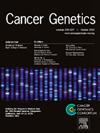39. Modifying cancer variant interpretation guidelines for the curation of histone H3 variants: The 'next step' of the Cl
IF 1.4
4区 医学
Q4 GENETICS & HEREDITY
引用次数: 0
Abstract
Histone H3 variants pose numerous challenges for curation due to varied nomenclature for their isoforms and encoding genes. These are further compounded by the tumor-specific settings in which histone H3 variants occur. Therefore, the Histone H3 SC-VCEP aimed to adapt and modify the ClinGen/CGC/VICC Oncogenicity SOP and AMP/ASCO/CAP guidelines for the interpretation of H3 variants specific to diffuse midline glioma, H3 K27-altered and diffuse hemispheric glioma, H3 G34-mutant.
The main proposed specifications to the ClinGen/CGC/VICC Oncogenicity SOP include: (1) the incorporation of trimethylation loss at the K27 residue and functional studies at G34 into evidence code OS2 and (2) stipulation of location at a 'conserved residue affecting epigenetic modification (e.g. histone H3 K27, G34, or K36)' for evidence code OM1.
The main proposed modifications to the ClinGen/CGC/VICC Oncogenicity SOP include: (1) an 'OS1_moderate' criterion (2 points), allowing for the same amino acid change as a previously established oncogenic variant in a homologous H3 gene; (2) an 'OS2_supportive' criterion (1 point), incorporating supportive evidence of frequent co-occurring variants (e.g. TP53, PDGFRA, ACVR1) or other supportive evidence of histone H3 mutation (e.g. gene expression analysis); and (3) an alternate OP2 criterion (1 point) applied when clinicopathologic features align with a corresponding histone mutant glioma in the WHO Classification. This novel modification introduces clinicopathological correlation into the assessment of oncogenicity. Evidence specifications have also been made to the AMP/ASCO/CAP guidelines.
Evaluation of our proposed changes to the guidelines is underway in a defined set of pilot variants.
39.修改癌症变异体解释指南,用于组蛋白 H3 变异体的整理:组蛋白 H3 变异的 "下一步
由于组蛋白 H3 异构体和编码基因的命名方法各不相同,因此组蛋白 H3 变异给文献整理工作带来了诸多挑战。组蛋白 H3 变体发生的肿瘤特异性环境又进一步加剧了这些挑战。因此,组蛋白 H3 SC-VCEP 旨在调整和修改 ClinGen/CGC/VICC 肿瘤致病性 SOP 和 AMP/ASCO/CAP 指南,以解释弥漫性中线胶质瘤、H3 K27 变异和弥漫性半球胶质瘤、H3 G34 突变的 H3 变异:(1) 将 K27 残基的三甲基化缺失和 G34 的功能研究纳入证据代码 OS2;(2) 规定证据代码 OM1 的位置为 "影响表观遗传修饰的保守残基(如组蛋白 H3 K27、G34 或 K36)":如 TP53、PDGFRA、ACVR1)或组蛋白 H3 突变的其他支持性证据(如基因表达分析);(3) 当临床病理特征与 WHO 分类中相应的组蛋白突变胶质瘤一致时,采用另一种 OP2 标准(1 分)。这一新颖的修改将临床病理学相关性引入致癌评估。AMP/ASCO/CAP指南也对证据进行了规范。目前正在一组确定的试点变异中评估我们对指南提出的修改建议。
本文章由计算机程序翻译,如有差异,请以英文原文为准。
求助全文
约1分钟内获得全文
求助全文
来源期刊

Cancer Genetics
ONCOLOGY-GENETICS & HEREDITY
CiteScore
3.20
自引率
5.30%
发文量
167
审稿时长
27 days
期刊介绍:
The aim of Cancer Genetics is to publish high quality scientific papers on the cellular, genetic and molecular aspects of cancer, including cancer predisposition and clinical diagnostic applications. Specific areas of interest include descriptions of new chromosomal, molecular or epigenetic alterations in benign and malignant diseases; novel laboratory approaches for identification and characterization of chromosomal rearrangements or genomic alterations in cancer cells; correlation of genetic changes with pathology and clinical presentation; and the molecular genetics of cancer predisposition. To reach a basic science and clinical multidisciplinary audience, we welcome original full-length articles, reviews, meeting summaries, brief reports, and letters to the editor.
 求助内容:
求助内容: 应助结果提醒方式:
应助结果提醒方式:


